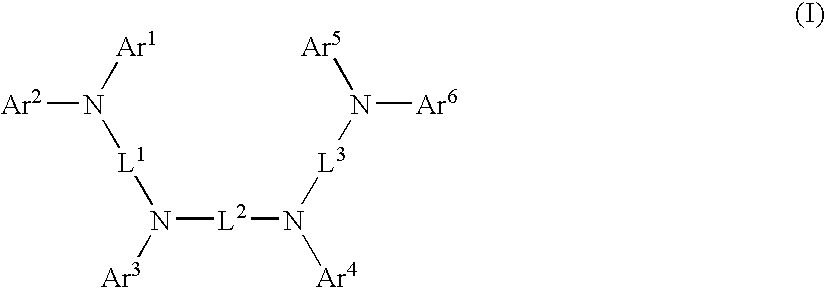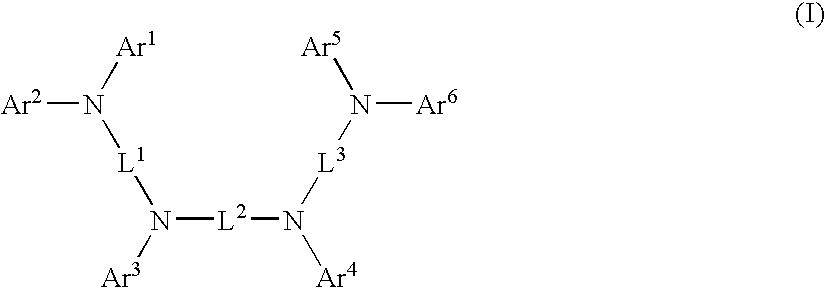Aromatic amine derivative and organic electroluminescence device employing the same
- Summary
- Abstract
- Description
- Claims
- Application Information
AI Technical Summary
Benefits of technology
Problems solved by technology
Method used
Image
Examples
synthesis example 1
Synthesis of N,N-diphenyl-4-amino-4′-iodo-1,1′-biphenyl
[0144] In a stream of argon, 1,058 g of N,N-diphenylamine (manufactured by Tokyo Chemical Industry Co., Ltd.), 2,542 g of 4,4′-diiodobiphenyl (manufactured by Wako Pure Chemical Industries, Ltd.), 1,296 g of potassium carbonate (manufactured by Wako Pure Chemical Industries, Ltd.), 39.8 g of a copper powder (manufactured by Wako Pure Chemical Industries, Ltd.), and 4 L of decalin (manufactured by Wako Pure Chemical Industries, Ltd.) were loaded and allowed to react with one another at 200° C. for 6 days.
[0145] After the reaction, the resultant was filtered during a hot state. Insoluble matter was washed with toluene, and was concentrated together with the filtrate. 3 L of toluene were added to the residue, a precipitated crystal was filtered out and removed, and the filtrate was concentrated. Then, 10 L of methanol were added to the residue, and the whole was stirred. After that, the supernatant was wasted, and 3 L of methanol...
synthesis example 2
Synthesis of N-(1-naphthyl)-N-phenyl-4-amino-4′-iodo-1,1′-biphenyl
[0146] In a stream of argon, 1,371 g of N-phenyl-1-naphthylamine (manufactured by Kanto Chemical Co., Inc.), 2,542 g of 4,4′-diiodobiphenyl (manufactured by Wako Pure Chemical Industries, Ltd.), 1,296 g of potassium carbonate (manufactured by Wako Pure Chemical Industries, Ltd.), 39.8 g of a copper powder (manufactured by Wako Pure Chemical Industries, Ltd.), and 4 L of decalin (manufactured by Wako Pure Chemical Industries, Ltd.) were loaded and allowed to react with one another at 200° C. for 6 days.
[0147] After the reaction, the resultant was filtered during a hot state. Insoluble matter was washed with toluene, and was concentrated together with the filtrate. 3 L of toluene were added to the residue, a precipitated crystal was filtered out and removed, and the filtrate was concentrated. Then, 10 L of methanol were added to the residue, and the whole was stirred. After that, the supernatant was wasted, and 3 L of...
synthesis example 3
Synthesis of N,N-di(2-naphthyl)-4-amino-4′-iodo-1,1′-biphenyl
[0148] In a stream of argon, 1,684 g of N,N-di(2-naphthyl)amine (manufactured by Nihon SiberHegner Co., Ltd.), 2,542 g of 4,4′-diiodobiphenyl (manufactured by Wako Pure Chemical Industries, Ltd.), 1,296 g of potassium carbonate (manufactured by Wako Pure Chemical Industries, Ltd.), 39.8 g of a copper powder (manufactured by Wako Pure Chemical Industries, Ltd.), and 4 L of decalin (manufactured by Wako Pure Chemical Industries, Ltd.) were loaded and allowed to react with one another at 200° C. for 6 days.
[0149] After the reaction, the resultant was filtered during a hot state. Insoluble matter was washed with toluene, and was concentrated together with the filtrate. 3 L of toluene were added to the residue, a precipitated crystal was filtered out and removed, and the filtrate was concentrated. Then, 10 L of methanol were added to the residue, and the whole was stirred. After that, the supernatant was wasted, and 3 L of me...
PUM
| Property | Measurement | Unit |
|---|---|---|
| Temperature | aaaaa | aaaaa |
| Time | aaaaa | aaaaa |
| Time | aaaaa | aaaaa |
Abstract
Description
Claims
Application Information
 Login to View More
Login to View More - Generate Ideas
- Intellectual Property
- Life Sciences
- Materials
- Tech Scout
- Unparalleled Data Quality
- Higher Quality Content
- 60% Fewer Hallucinations
Browse by: Latest US Patents, China's latest patents, Technical Efficacy Thesaurus, Application Domain, Technology Topic, Popular Technical Reports.
© 2025 PatSnap. All rights reserved.Legal|Privacy policy|Modern Slavery Act Transparency Statement|Sitemap|About US| Contact US: help@patsnap.com



